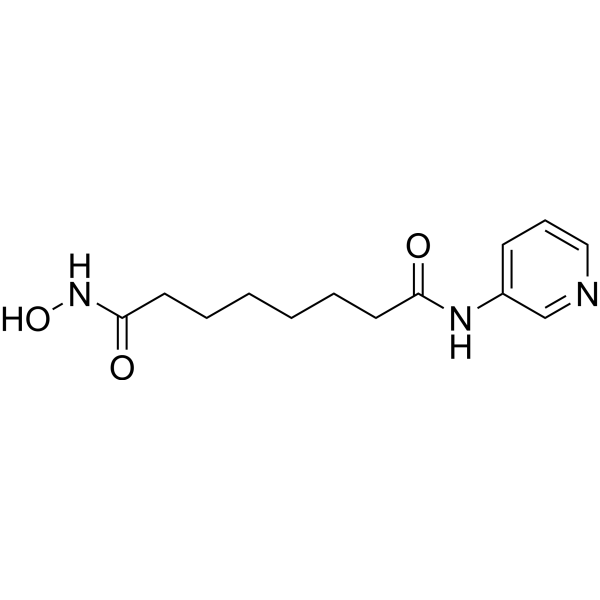Physicochemical Properties
| Molecular Formula | C13H19N3O3 |
| Molecular Weight | 265.31 |
| Exact Mass | 265.142 |
| CAS # | 382180-17-8 |
| PubChem CID | 4996 |
| Appearance | White to off-white solid powder |
| Density | 1.2±0.1 g/cm3 |
| Index of Refraction | 1.570 |
| LogP | 0.04 |
| Hydrogen Bond Donor Count | 3 |
| Hydrogen Bond Acceptor Count | 4 |
| Rotatable Bond Count | 8 |
| Heavy Atom Count | 19 |
| Complexity | 284 |
| Defined Atom Stereocenter Count | 0 |
| InChi Key | PTJGLFIIZFVFJV-UHFFFAOYSA-N |
| InChi Code | InChI=1S/C13H19N3O3/c17-12(15-11-6-5-9-14-10-11)7-3-1-2-4-8-13(18)16-19/h5-6,9-10,19H,1-4,7-8H2,(H,15,17)(H,16,18) |
| Chemical Name | N'-hydroxy-N-pyridin-3-yloctanediamide |
| HS Tariff Code | 2934.99.9001 |
| Storage |
Powder-20°C 3 years 4°C 2 years In solvent -80°C 6 months -20°C 1 month |
| Shipping Condition | Room temperature (This product is stable at ambient temperature for a few days during ordinary shipping and time spent in Customs) |
Biological Activity
| Targets | HDAC1 100 nM (ID50) |
| ln Vitro | Pyroxamide (1.25 -20.0 μM; 24-72 hours) suppresses the development of RH30B and RD cells, resulting in 44% dead cells at 20.0 μM and 86% dead cells in culture after 72 hours [1]. Pyroxamide (10.0 – 20.0 μM; 48 hours) exhibits sub-G1 fractions of 45.0% and 72.3% at 10.0 and 20.0 μM, in that order [1]. |
| Cell Assay |
Cell Viability Assay[2] Cell Types: RD cells; RH30B cells Tested Concentrations: 1.25-20.0 μM Incubation Duration: 24 hrs (hours); 48 hrs (hours); 72 hrs (hours) Experimental Results: Resulted in a cell growth decrease in RD and RH30B cells. Cell Cycle Analysis[2] Cell Types: RD cells; RH30B cells Tested Concentrations: 10.0 μM; 20.0 μM Incubation Duration: 48 hrs (hours) Experimental Results: Increased the sub-G1 fractions at 48 hrs (hours) compared with control samples. |
| References |
[1]. Inhibition of transformed cell growth and induction of cellular differentiation by pyroxamide, an inhibitor of histone deacetylase. Clin Cancer Res. 2001 Apr;7(4):962-70. [2]. Histone deacetylase inhibitors induce growth suppression and cell death in human rhabdomyosarcoma in vitro.Clin Cancer Res. 2003 Nov 15;9(15):5749-55. |
| Additional Infomation |
N'-hydroxy-N-(3-pyridinyl)octanediamide is an aromatic amide. Pyroxamide has been used in trials studying the treatment of Leukemia, Lymphoma, Small Intestine Cancer, Precancerous Condition, and Myelodysplastic Syndromes, among others. Pyroxamide is a synthetic derivative of hydroxamic acid with antineoplastic properties, Pyroxamide inhibits histone deacetylases involved in transcription; induces hyperacetylation of core histones, modulating chromatin structure and affecting transcription of some genes that inhibit tumor growth; and induces growth arrest and apoptosis. Pyroxamide is used in clinical studies for cancer chemotherapy. (NCI04) |
Solubility Data
| Solubility (In Vitro) | DMSO : 125 mg/mL (471.15 mM) |
| Solubility (In Vivo) |
Solubility in Formulation 1: ≥ 2.08 mg/mL (7.84 mM) (saturation unknown) in 10% DMSO + 40% PEG300 + 5% Tween80 + 45% Saline (add these co-solvents sequentially from left to right, and one by one), clear solution. For example, if 1 mL of working solution is to be prepared, you can add 100 μL of 20.8 mg/mL clear DMSO stock solution to 400 μL PEG300 and mix evenly; then add 50 μL Tween-80 to the above solution and mix evenly; then add 450 μL normal saline to adjust the volume to 1 mL. Preparation of saline: Dissolve 0.9 g of sodium chloride in 100 mL ddH₂ O to obtain a clear solution. Solubility in Formulation 2: ≥ 2.08 mg/mL (7.84 mM) (saturation unknown) in 10% DMSO + 90% (20% SBE-β-CD in Saline) (add these co-solvents sequentially from left to right, and one by one), clear solution. For example, if 1 mL of working solution is to be prepared, you can add 100 μL of 20.8 mg/mL clear DMSO stock solution to 900 μL of 20% SBE-β-CD physiological saline solution and mix evenly. Preparation of 20% SBE-β-CD in Saline (4°C,1 week): Dissolve 2 g SBE-β-CD in 10 mL saline to obtain a clear solution. Solubility in Formulation 3: ≥ 2.08 mg/mL (7.84 mM) (saturation unknown) in 10% DMSO + 90% Corn Oil (add these co-solvents sequentially from left to right, and one by one), clear solution. For example, if 1 mL of working solution is to be prepared, you can add 100 μL of 20.8 mg/mL clear DMSO stock solution to 900 μL of corn oil and mix evenly. (Please use freshly prepared in vivo formulations for optimal results.) |
| Preparing Stock Solutions | 1 mg | 5 mg | 10 mg | |
| 1 mM | 3.7692 mL | 18.8459 mL | 37.6918 mL | |
| 5 mM | 0.7538 mL | 3.7692 mL | 7.5384 mL | |
| 10 mM | 0.3769 mL | 1.8846 mL | 3.7692 mL |
